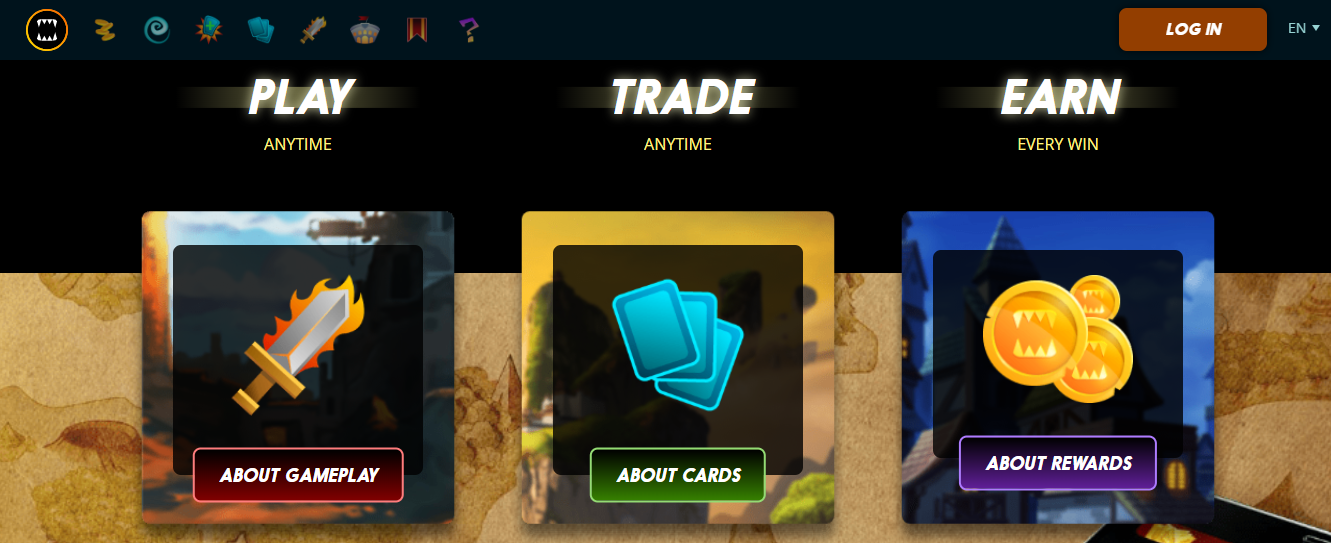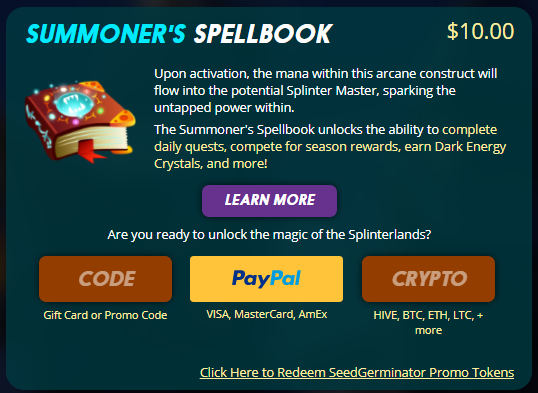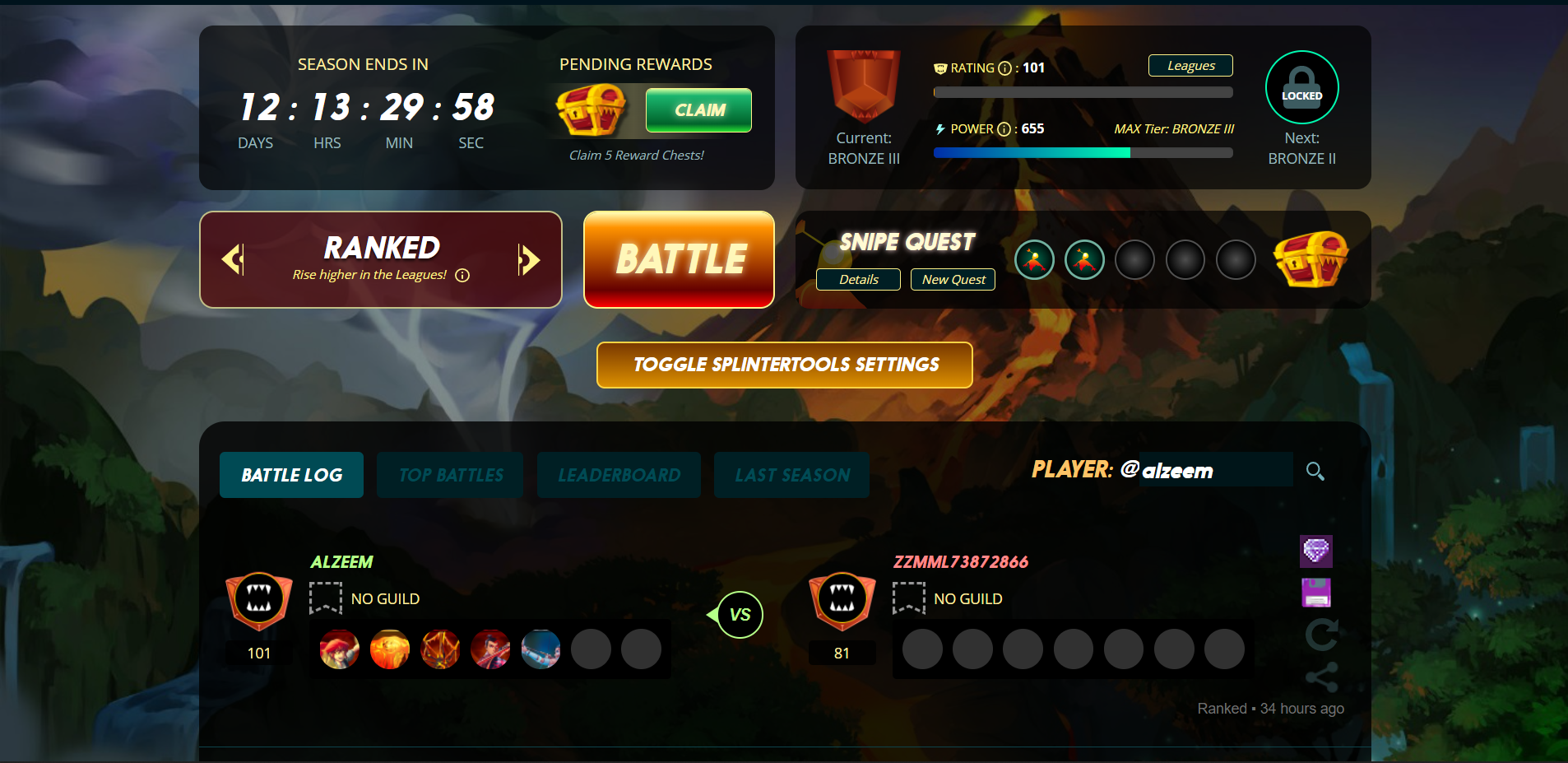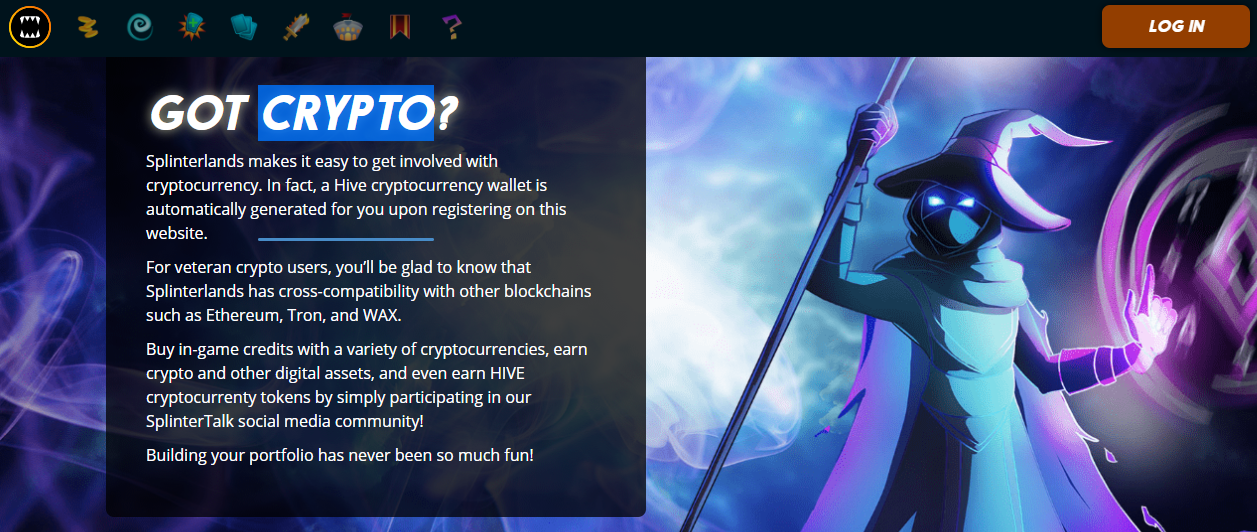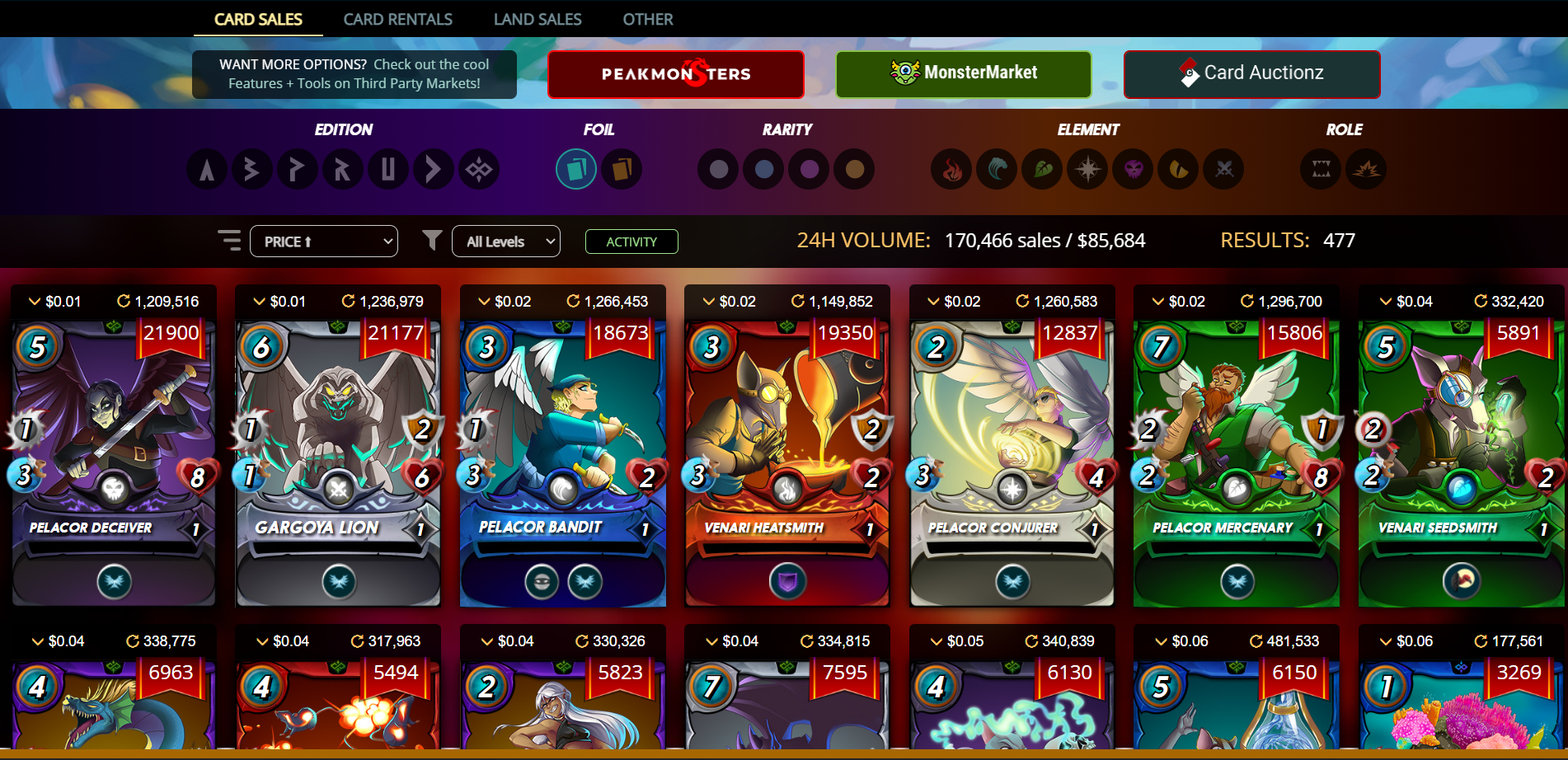- DeFi Kingdoms Dueling Guide: Something is Better than Nothing - November 4, 2022
- Infinite Fleet Game Overview - October 30, 2022
- Best NFT marketplaces for gamers: All About Those Non-Fungible Tokens - October 9, 2022
Splinterlands is a trading card game built on the Hive blockchain with quick battles, libraries of cards, and a thriving community of dedicated players. It’s a game that has a lot to offer players but does very little to explain any of its numerous features to them.
It’s like the entirety of Yu-Gi-Oh! and the Pokémon Trading Card Game all on one website and, frankly, it’s a bit overwhelming.
I started playing Splinterlands in the fall of 2021. Ah, I remember the days. Crypto was going nowhere but up. A different web3 game was released every week. And Splinterlands had finally proved itself as a lasting contender in the crypto gaming space.
Things are a wee bit different now, but Splinterlands continues regardless of market conditions or competition.
I won’t lie to you, going through the tutorial and introduction of Splinterlands was, for me, surprisingly cheesy. I still can’t get over the low quality of their artwork. But back then I was eager to get my hands on some cards and Dark Energy Crystals (DEC). I was looking forward to getting that same feeling I had when playing a holographic Charizard in Pokémon tournaments as a kid.
I did not get that feeling.
I still have not gotten that feeling.
But, I have gotten my hands on some DEC, credits, and SPS. And I own a nice collection of powerful cards. Well, powerful to me. And while I may not get giddy when I own noobs in the lower leagues, I can still appreciate Splinterlands for what it is: an evolved and mature trading card game built on its blockchain.
So, if you’re thinking about jumping into Splinterlands but want to avoid the steep learning curve and sensory overload of its dashboard screen, then this guide is for you.
Before You Begin: Setting Up An Account
Before you can buy a Summoner’s Spellbook–before you can even play a match–you’ll need to create an account and work your way through the aforementioned cheesy tutorial.
Setting up your account should take no less than a few minutes and requires only an email address. When your account is created, a Hive wallet is created along with it to hold all your Splinterlands assets. No purchase is required at this point.
And just like that, your account is created and you can now start getting a feel for the Splinterlands universe. If you want to start earning cryptocurrency for your time in Splinterlands, you’ll have to pony up $10 for a Summoner’s Spellbook.
Do You Even Want To Buy The Summoner’s Spellbook?
The first thing you should do once you have your account set up and the introduction is complete and you’re looking at your dashboard is to decide whether this is a game you even want to invest in.
How does one do that?
Once the tutorial is over, navigate over to the battle screen and play at least 10 practice battles. You can do more if you like, but this is the quickest way to familiarize yourself with the game, its mechanics, and cards. Just play. Win a few hands, lose a few hands. Get a feel for whether or not this is a game you can see yourself playing and putting money into.
Because take it from me, once you make that initial investment, you’re going to make more. You may not make many more, but you’re going to make more.
So, before the floodgates of your preferred financial institution open and pour out their contents into a virtual trading card game, make sure this is a virtual trading card game you want to be a part of.
First hour/day/week in the game
Giving yourself some realistic goals to shoot for during your beginner phase of Splinterlands is a wise idea. You won’t be making money in your first battle and you won’t be winning tournaments on your first day. But, you will learn all the jargon and vocabulary necessary to be successful, and you might even complete your first quest.
Your First Hour In Splinterlands
Maybe you’ve bought the Spellbook, maybe you haven’t. Regardless, your first hour on Splinterlands should be spent grinding through battles.
There’s a lot of content to sift through on Splinterlands, but you can take your time getting to it. For now, focus on fighting. To that end, here are some critical mechanics you should know by the end of your first hour.
- Countdown
- Mana Cap
- Rules
- Elements
- Recently Played
- Guild
- Power
Some of the mechanics are fairly self-explanatory. But when I first started in Splinterlands, I would’ve benefitted from someone taking the time to break down a few of the others.
Mana Cap
Each card in Splinterlands has a mana cost associated with it. To add it to your deck, you’ll have to pay the amount of mana it needs. Every match in Splinterlands comes with a mana cap, a limit to how much mana you can spend in a battle. The number could be as low as 12 and as high as 30 for beginners. The higher the mana cap, the more cards you can put in your deck.
Recently Played
This is a great feature to help you anticipate what deck your opponent might play. Listed under Recently Played will be up to 5 elemental symbols that indicate the last 5 decks played by your opponent. If you see five death symbols there, you know your opponent is spamming a Cursed Windeku deck. If you see a mixture of fire and earth and dragon, you should know you’re playing against a formidable opponent who likes to mix it up.
Power
Power is a number that’s based on the level, strength, and quantity of a player’s card collection. The more cards you own, the higher the number. The stronger your cards and the higher their level, the more power you’ll have. It’s a good indicator of the current strength of your opponent.
By the time you’re complete with your first hour in Splinterlands, you’ll have knowledge and experience under your belt. You’ll have learned which decks kick your butt, you should know that low mana caps are dumb, and you’ll have a favorite element to play. All valuable information.
Your First Day In Splinterlands
Now we broaden the lens and explore everything Splinterlands has to offer. These sections are going to take a bit of time for you to explore fully, which is why I put them under your first day. Heck, it might even take you longer than that to work your way through everything.
At the end of your first day, you should be more than familiar with each of these areas of Splinterlands. Again, some of them will be easy enough for you to explore and understand. But a few of them had me scratching my head and taking notes before it clicked, so let’s jump into those.
Shop
This is where you can purchase anything that isn’t a single card. Card packs, potions, Hive nodes, different skins for your characters, special event items, and even land can be purchased here. This is where you’ll go once you’ve earned enough credits to purchase a pack. The cheapest pack costs 4,000 credits, which equals $4. You can also use DEC and vouchers to purchase several items in the shop.
|
Item |
Price |
|
1 Card Pack |
4,000 credits/$4 |
|
Land |
Sold Out |
|
Hive Nodes |
Presale |
|
Special Event |
~5,000,000 credits/$5,000 |
|
1 Legendary Potion |
40 credits/$.04 |
|
1 Alchemy Potion |
50 credits/$.05 |
|
1 Quest Potion |
750 DEC |
|
Cosmetic Skins |
2,000 DEC |
Market
This is Splinterlands’ market for single cards. You’ll find just about every card in the game offered here. Prices start at $.01 and climb as high as $30,000. But they’re all in credits, so if you want to make a purchase you’ll have to deposit some more money into your account and convert it over to credits.
You can buy or rent from the Splinterlands marketplace on this screen, or you can select from any of the 3rd party marketplaces linked to the top of the page, like Peakmonsters, MonsterMarket, and Card Auctionz. Prices are mostly the same across all sites, but I did find some better discounts on the 3rd party markets compared to Splinterlands’. So, if you’re looking for the best deals, I highly recommend you check out non Splinterlands markets.
Battle
Probably the screen you’ll spend the most time on, the Battle screen is where all the action takes place. Practice, tutorials, friendly duels, and ranked matches are all live here. This screen is hefty, so I’ll break it down with some helpful hints.
- Quests: There is a daily quest in Splinterlands just waiting for you to complete. They always involve winning 5 battles in a specific way. Life Quest: Win 5 battles with the life element. Sneak Quest: Win 5 battles with a Sneak monster. Etc, etc. When you complete the quest, you’ll earn a single chest. Open the chest to earn some credits or potions.
- Season/League: Seasons move crazy fast in Splinterlands. The last 14 days on average. When a season ends, you will earn rewards based on where you rank. If you end the season in the bronze league, you earn anywhere from 5 to 9 chests. The higher your rank, the more chests you’ll earn. You’ll see a big countdown clock on the Battle screen that lets you know when the season will end.
|
League |
Reward |
|
Novice |
0 Chests |
|
Bronze Tier I |
5 Chests |
|
Bronze Tier II |
7 Chests |
|
Bronze Tier III |
9 Chests |
|
Silver Tier I |
12 Chests |
|
Silver Tier II |
15 Chests |
|
Silver Tier III |
18 Chests |
|
Gold Tier I |
22 Chests |
|
Gold Tier II |
26 Chests |
|
Gold Tier III |
30 Chests |
|
Diamond Tier I |
40 Chests |
|
Diamond Tier II |
50 Chests |
|
Diamond Tier III |
60 Chests |
|
Champion I |
80 Chests |
|
Champion II |
120 Chests |
|
Champion III |
150 Chests |
- Rating: This is a number determined by your power and the number of consecutive ranked matches you’ve won. It’s only helpful in calculating which league you belong in.
- Battle Log: Here you’ll find a history of all your matches in the current season. This is for more than reminding you how many matches you’ve lost. It’s to help you analyze your strategy. Scrolling through and piecing together what contributed to your losses, or your wins, is a habit you should pick up quickly.
- Top Battles: These are the best battles in your current league. This is where you can spectate and watch other players duke it out. Watching other players fight allows you to gain valuable knowledge about match-ups and card strategies without sacrificing your place in the league.
- Last Season: This tab will display the final rankings for each player in your league for the previous season. It also displays what each player received as a reward, how many battles they played, and their highest win streak. It helps figure out what you need to do to climb the ranks.
Events
Enter the arena, challenger! This is where you’ll find all the official Splinterlands tournaments. Sponsored by players or guilds and featuring all kinds of specific rules and regulations, tournaments are where you can test your true skills and earn some hefty rewards.
Don’t be fooled and think this is only for the higher leagues, there are plenty of tournaments specifically for bronze league players as well as gold and diamond. At the time of writing, at least 20 tournaments are being held with prize pools ranging from $4 to $250.
Holy cow! You made it through each of the tabs, dove deep into all of them, and now your brain is full to bursting. Congrats. But, you’ll have to make room for more knowledge because we’re not done with the first day yet.
What’s The Difference Between Credits, Dark Energy Crystals (DEC), and Splintershards (SPS)?
Splinterlands uses three different virtual currencies to run its game. They each have a different use in the game and they each are obtained differently. DEC and SPS are the only true cryptocurrencies in Splinterlands, where credits are your traditional in-game currency.
Credits
Credits have a great ratio to the dollar. For every 1,000 credits you own, you have $1. 4,000 credits = $4. 40,000 = $40. You get the point.
Credits can be obtained by opening reward chests either from daily quests or at the end of the season. You won’t find many credits in those chests, though. I opened my daily quest chest this morning and got a total of 8 credits. Oh boy!
Credits will be used in all the different marketplaces on Splinterlands. You can buy and rent cards with them, you can purchase card packs, and you can resupply your potion collection. Credits are also easy to purchase since Splinterlands is integrated with Paypal.
Dark Energy Crystals
DEC is the official cryptocurrency of Splinterlands. And it’s something you won’t get any of for a while. Once you start working your way up through the ranks, you’ll eventually reach bronze league tier 2. From that tier up, you’ll earn DEC with every victorious match you play. But even once you start earning DEC, it will be dismally low. Keep your chin up, keep battling up through the leagues, and you’ll see the number of DEC you earn steadily go up.
Splintershards
This is a new addition to Splinterlands, not something rolled out with the original release. Mainly because web3 has learned a lot recently, and one of those lessons is that governance tokens are sort of necessary. They allow members of your community to voice their opinion and dictate where the game moves in the future.
To remedy Splinterlands’ lack of a governance token, they introduced the SPS token. SPS can be earned by merely playing the game. The Hive blockchain will note how much activity you’re producing on the chain and reward you accordingly.
At the end of each season, you should take all the SPS you’ve earned and stake it. Staking is a way to make your SPS earn more SPS passively, while still earning SPS for playing the game. And remember those vouchers in the Shop I mentioned earlier? The only way to get them is to stake your SPS.
Your First Week In Splinterlands
Wow, you survived all of that and you still want to play Splinterlands? Really? You purchased the Spellbook, you have your favorite summoner, and you’ve completed your first quest? Way to go! Now it’s time to hone all those skills to a fine, fighting edge.
Your first week in Splinterlands should be spent beating daily quests. Your goal is to earn as many potions and credits as possible. In the process of completing quests, you should find yourself in at least bronze league tier 3. This means at the end of the season you’ll earn yourself 5 reward chests, with more potions and credits, and if you’re lucky a card pack.
Core Mechanics of Splinterlands: Positioning
A lot is going on in Splinterlands, as you’ve likely pieced together by now, but the mechanics of the gameplay are surprisingly dull and narrow. I’m pretty sure the complexity of Axie Infinity is more complicated that Splinterlands. The elements don’t play much of a role, the rules aren’t that imaginative, and eventually, you realize many cards all do the same thing.
The heart of Splinterlands gameplay boils down to positioning your cards correctly. Where should your tank card go? What about your snipe? Do you have a healer and if so what position are they going in?
That’s all up for you to decide. Everyone plays their deck differently. But, as you start in the wide world of Splinterlands, you should follow a few fundamental rules about positioning:
Always have your tank card first.
Always have a ranged, opportunity, or snipe monster in your deck.
Choose more health and speed over any other buff.
These tips served me well, once I learned them, and I’m sure they’ll take you far, as well. Once you get into more advanced leagues you’ll encounter more advanced tactics. But following these hints should see you skate past a lot of the speedbumps that tripped me up.
Things We Wish We Knew Sooner
Well, technically everything I’ve written about so far I wish I knew sooner. I felt like I was floundering around in this game for weeks before I figured it all out. But, if I had to pass on the most important bit, it’d be this.
More Money Does Not Mean More Victories
When I first started playing Splinterlands, I thought to myself, “$10 isn’t that much of an investment in a game. Heck, I spend about $30 on traditional video games. Why don’t I invest $15-$20 more in Splinterlands? Then I’ll have an advantage over everyone else who merely bought the Spellbook and chose to grind their way into some credits, right?”
Wrong.
Just because you invest more money into Splinterlands doesn’t mean you’ll be winning more often. It just means you have more money to throw at the game. Sure, having more options for your deck always helps. But more likely what will happen is you end up buying cards too early in your Splinterlands experience; you don’t know your playstyle or preferred strategies, but you see high damage cards and think they’ll do nicely in your deck. They won’t. At least in my case, I have a lovely collection of cards I never use but I thought they were strong when I started playing so I splurged on them. They’re not strong and they don’t work with my strategy in the slightest.
Take the time to learn your playstyle. Develop your preferred strategy before you go out and start buying cards to compliment your deck. Snipe monsters are awesome, but maybe you’d rather use opportunity monsters instead? Likewise, monsters with the shield ability are natural tank cards, but perhaps you prefer monsters with the dodge ability? I do.
This is why spending your first foray into Splinterlands in the fires of battle is so important. Who are you as a player? What are your strengths and weaknesses? Once you know, then you can start investing more.
Common Mistakes to Avoid
Don’t Hoard Your Potions
Use them! Splinterlands rewards you with potions for a reason. I held onto them in the beginning, thinking they were rare and valuable and should only be used on special occasions. I could not be more incorrect. Use them liberally. You can always buy more in the shop and they are quite cheap.
Don’t Get Discouraged
This is highly important. Splinterlands is a fun game that offers the opportunity to earn money. But at the end of the day, it’s just a game. If you signed up for Splinterlands for the sole purpose of making money, you got into it for the wrong reasons. If you’re only playing for the profit, you’re going to find very quickly that a good deal of time and work is needed to make that profit.
Some players manage to earn sizeable monthly profits from Splinterlands.
Most don’t.
If you find yourself getting frustrated or burned out while playing, remember that it’s just a game.
Keep playing. Keep learning. Keep growing your card collection. One day you’ll be able to say you’re making a profit. Just don’t get discouraged along the way.
Long Term Goals
Join A Guild
Guilds don’t let just anyone in off the internet. You need to prove yourself in ranked matches first. Or have a friend who can send you an invite. Either way, it’s not something that will happen in your first month of playing. But, with an operose attitude and at least 5,000 power, you can start applying to guilds. That’s going to take some time and a lot of losses, but guilds offer generous passive bonuses. And even the lowest level guild will work to your benefit almost immediately upon joining.
Rent Out Your Cards
This is something you should only consider once you have multiples of high-level, powerful, or rare cards. Otherwise, why would anyone rent your card if hundreds of other people are offering the same card? But, once you’ve built up your deck and have a few cards in your collection that you never use, consider putting them up for rent. It’s a great way to earn credits passively.
Reach A High(er) Rank
This is subjective to each player, but you should make a goal of reaching a specific rank. The only question is, what is a high rank to you? When I first started playing, I thought the gold league was a good goal to aim at. But once I learned just how much work it was to get into the second tier of the bronze league, I rapidly changed my goalposts. Some people have quit their jobs to play Splinerlands full-time, and even some of them haven’t reached the gold league. It’s a tough grind. So, place a goal on a league you think is high and start kicking ass to reach it. It might be the silver league, it might the third tier of the bronze league. Or, you could shoot for the stars and aim for the diamond league. Whatever you decided, don’t settle for anything lower.
FAQ
Question: Is there a story to Splinterlands? Fanfiction? Lore?
Answer: Yes and no. While playing the game you will encounter no story. No fiction. No lore. However, if you mosey on over to Splinterlore.com you’ll find everything the game lacks. Character history, world-building, deep lore–you name it. They even have fan art competitions.
Question: How much can I expect to earn in Splinterlands?
Answer: The answer to that question varies wildly. How much time are you putting in a week? How much of an investment did you make? Are you staking SPS? Are you renting out cards? Do you have multiple accounts? Are you only earning DEC from victories? A friend of mine who owns five different accounts and plays at least an hour a day earns about $13 a day. At the same time, an influencer I follow online makes about $1300 a month from his one account, but he plays 6-7 hours a day and has put over $2,000 into the game. When you start you won’t be earning DEC for a while and you probably won’t have 6-7 hours to play a day. So, how much can you expect to make as a beginner? Virtually nothing.
Question: What’s a Chaos Legion and how do I get one?
Answer: The Chaos Legion is the current theme or season for card packs in Splinterlands. Meaning, that any pack you buy right now is from the Chaos Legion theme. The symbol at the top of a card will tell you what theme it belongs to. There are seven in total. Just about any card you purchase right now, certainly all the ones on Splinterlands’ marketplace, are from the Chaos Legion. Players have hoarded packs from previous themes, but good luck getting your hands on those.
Question: Can I play Splinterlands on mobile?
Answer: No. I mean, you can certainly try. But once you see the battle screen and all the data that’s shoved onto it, you’ll realize very quickly that mobile gameplay is a thumbs down. There’s no way for you to interact with all the tiny buttons. I tried once while on vacation and away from my computer. Other crypto games are mobile-friendly, why not Splinterlands? Trust me. It just doesn’t work.
Final Thoughts
Splinterlands has one of the largest communities in the crypto gaming space and they continue to grow. They are constantly innovating and adapting to adjust to the gaming industry and player sentiment.
Despite their rabid fan base and dedicated development team, there are plenty of pitfalls to Splinterlands. Again, who designs the cartoons for their cards? An art college dropout?
I digress.
Its steep learning curve, low payout of DEC, and stupid mana caps all chaffed me as I played. The long road to a league of any semblance made me feel like I’d never win anything and the high cost of card packs always gave me a frown.
That said, if you are someone who likes card and strategy games, this is right up your alley. If you’re looking to get into a community of welcoming and cooperative players, this is your game. And you can even earn money while you play! What’s better than that?
For more reading on crypto games worth your time, check out The Sandbox: A Gaming Review
For more interesting reading check out:

